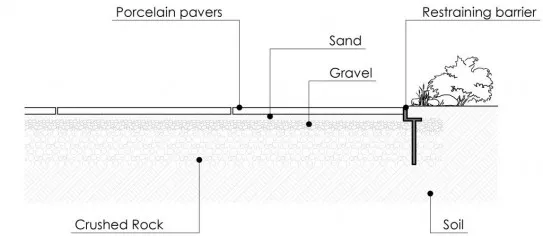20mm Porcelain Paver Installation Instructions
Porcelain pavers on a gravel/sand bed
- Ensure that the area has a minimum 2° slope for drainage and that it is directed away from any building.
- Define the area to be excavated and mark its perimeter with marker posts connected by a string. The excavation area should be extended by approximately 200mm on all sides for stability.
- Remove the soil inside the marked area using a shovel or excavator. The excavation depth will depend on factors such as anticipated loading, soil drainage capacity, and soil conditions.
- Level the excavated area using a rake or shovel and ensure a 2° slope for drainage.
- Compact the soil with a vibrating compactor.
- Install a restraining perimeter wall or ensure that it is in direct contact with a footpath, wall, or a sufficiently rigid edge. Fix the wall to the ground with mechanical devices or construct a solid barrier using poured concrete.
- Place a geo textile fabric sheet on the compacted soil to prevent soil from mixing with the gravel.
- Fill the excavated area with 15-20mm stone screenings to a thickness of 200-300mm, depending on planned loading.
- Add a 10mm layer of gravel with a thickness of 100-200mm.
- Compact the two layers and level, ensuring a 2° slope.
- Place another geo textile fabric sheet on top of the compacted gravel to prevent it from mixing with sand.
- Fill the area with paving sand to a thickness of 20-25mm and compact with a vibrating compactor.
- Level the surface by sliding a wood or steel board on two parallel runners across the area, ensuring a 2° slope.
- Carefully lay the paving slabs using 3mm spacers and avoid butt jointing.
- Tap the pavers with a rubber mallet to ensure stability and level with each other. Fill the joints with polymeric sand suitable for porcelain tiles.
Porcelain pavers on grass
- To start, arrange the pavers on the ground to calculate the number of steps required for the garden path. Ensure that the pavers are positioned evenly apart from each other.
- Determine the desired width of the joints between the pavers. If the pavers are used as stepping stones or in a pathway, they are usually laid with open joints and grass in between. However, if they will be in areas with outdoor furniture, pavers are typically laid with 3mm joints filled with polymeric sand suitable for porcelain tiles.
- Mark the boundary of each paver with a spade, then remove the pavers.
- Dig out the turf to a depth of 50-75mm.
- Fill the area with a layer of fine 5-10mm gravel and compact the layer. Alternatively, lay a 25mm layer of sand for a bed for the pavers.
- Lay the pavers so they rise above the ground level by 6-10mm, but not above the lawn level to avoid damaging lawn mower blades during grass cutting.
- Gently tap the pavers with a rubber mallet to secure them in place.
Porcelain pavers for elevated deck applications
- Elevated deck construction can be simplified with the use of adjustable height pedestal supports. These provide a level surface on sloped or uneven ground, eliminating the need for complicated substructures.
- Pavers can be laid directly on the pedestals or on a system of hollow steel beams, depending on the width of the pavers.
- For the best results, it is advised to follow the manufacturer's instructions when installing pavers using the pedestal system. Electrical cables and pipes can also be easily hidden underneath the pavers and can be inspected by simply lifting individual tiles.
Porcelain pavers on a concrete base
- Verify concrete is in good condition, installed with 2° pitch from building & reinforced with steel mesh
- Clean concrete surface for good adhesion
- Spread thin set mortar with 3mm-5mm joint spacing
- Lay pavers on thin set and grout with exterior grade grout
- Wash pavers & use buffered acid wash to remove grout residue
- Optionally, use Tile Sand (proprietary sand for porcelain pavers) instead of grout.


